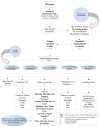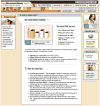Web-based nutrition education for college students: Is it feasible?
- PMID: 21494421
- PMCID: PMC3074521
- DOI: 10.1016/j.evalprogplan.2005.04.018
Web-based nutrition education for college students: Is it feasible?
Abstract
College students have poor nutrition habits and often exhibit at-risk weight control behaviors; yet, health promotion efforts on campuses often target other risk behaviors such as alcohol and tobacco use. The goal of this study was to determine program content and examine the feasibility of a web-based nutrition education program for college students using innovative applications of tailoring, targeting and personalization of information. Comprehensive program planning entailed three phases: focus groups and use of concept mapping methodology, prototype web program development, and feasibility testing of the prototype. Results of concept mapping suggested that students and experts agreed on the relative importance of the major content areas unique to the college audience. A prototype web program, informed by health promotion theories, was developed and evaluated. Students and college health professionals participated in the feasibility evaluation, which included acceptance and usability testing of the prototype. Mean scores were computed for the acceptance ratings that indicated that the prototype web program was not only feasible, but also compelling and relevant for the college audience. In conclusion, a tailored, web-based interactive nutrition program could potentially be used to provide individualized nutrition information to encourage college students to adopt healthy eating behaviors.
Figures


Similar articles
-
Web-Based Tool Designed to Encourage Supplemental Nutrition Assistance Program Use in Urban College Students: Usability Testing Study.JMIR Form Res. 2024 Jun 13;8:e50557. doi: 10.2196/50557. JMIR Form Res. 2024. PMID: 38869926 Free PMC article.
-
SNAP-Ed Programming for College Students Experiencing Food Insecurity: A Qualitative Process-Focused Evaluation.J Acad Nutr Diet. 2024 May;124(5):607-627. doi: 10.1016/j.jand.2023.11.025. Epub 2023 Dec 3. J Acad Nutr Diet. 2024. PMID: 38052305
-
Community-Based Participatory Research: Partnering with College Students to Develop a Tailored, Wellness-Focused Intervention for University Campuses.Int J Environ Res Public Health. 2022 Dec 6;19(23):16331. doi: 10.3390/ijerph192316331. Int J Environ Res Public Health. 2022. PMID: 36498404 Free PMC article.
-
The Building Healthy Eating and Self-Esteem Together for University Students Mobile App to Treat Eating Disorders: User-Centered Research Design and Feasibility Study.JMIR Form Res. 2023 Jul 12;7:e43504. doi: 10.2196/43504. JMIR Form Res. 2023. PMID: 37436790 Free PMC article.
-
Feasibility of a prototype web-based acceptance and commitment therapy prevention program for college students.J Am Coll Health. 2014;62(1):20-30. doi: 10.1080/07448481.2013.843533. J Am Coll Health. 2014. PMID: 24313693 Free PMC article. Clinical Trial.
Cited by
-
Perceptions of Health Among Black Women in Emerging Adulthood: Alignment With a Health at Every Size Perspective.J Nutr Educ Behav. 2022 Oct;54(10):916-924. doi: 10.1016/j.jneb.2022.07.004. Epub 2022 Aug 30. J Nutr Educ Behav. 2022. PMID: 36055946 Free PMC article.
-
Whole Grain Muffin Acceptance by Young Adults.Foods. 2018 Jun 13;7(6):91. doi: 10.3390/foods7060091. Foods. 2018. PMID: 29899237 Free PMC article.
-
Collective conceptualization of parental support of dual career athletes: The EMPATIA framework.PLoS One. 2021 Sep 22;16(9):e0257719. doi: 10.1371/journal.pone.0257719. eCollection 2021. PLoS One. 2021. PMID: 34551023 Free PMC article.
-
Preliminary evaluation of a scenario-based nutrition literacy online programme for college students: a pilot study.Public Health Nutr. 2023 Dec;26(12):3190-3201. doi: 10.1017/S1368980023002471. Epub 2023 Nov 6. Public Health Nutr. 2023. PMID: 37927137 Free PMC article. Clinical Trial.
-
Identifying the educational needs of menopausal women: a feasibility study.Womens Health Issues. 2011 Mar-Apr;21(2):145-52. doi: 10.1016/j.whi.2010.10.001. Epub 2010 Dec 24. Womens Health Issues. 2011. PMID: 21185735 Free PMC article.
References
-
- Ackard DM, Croll JK, Kearney-Cooke A. Dieting frequency among college females: Association with disordered eating, body image and related psychological problems. Journal of Psychosomatic Research. 2002;52:129–136. - PubMed
-
- American School Health Association. The National adolescent health survey: A report on the health of America’s youth. Oakland, CA: Third Party Publishing; 1989.
-
- Anderson DA, Shapiro JR, Lundgren JD. The freshman year of college as a critical period for weight gain: An initial evaluation. Eating Behavior. 2003;4:363–367. - PubMed
-
- Belaski A. College and university students present a challenge for nutritionists. Journal of the American Dietetic Association. 2001;101:913. - PubMed
Grants and funding
LinkOut - more resources
Full Text Sources

